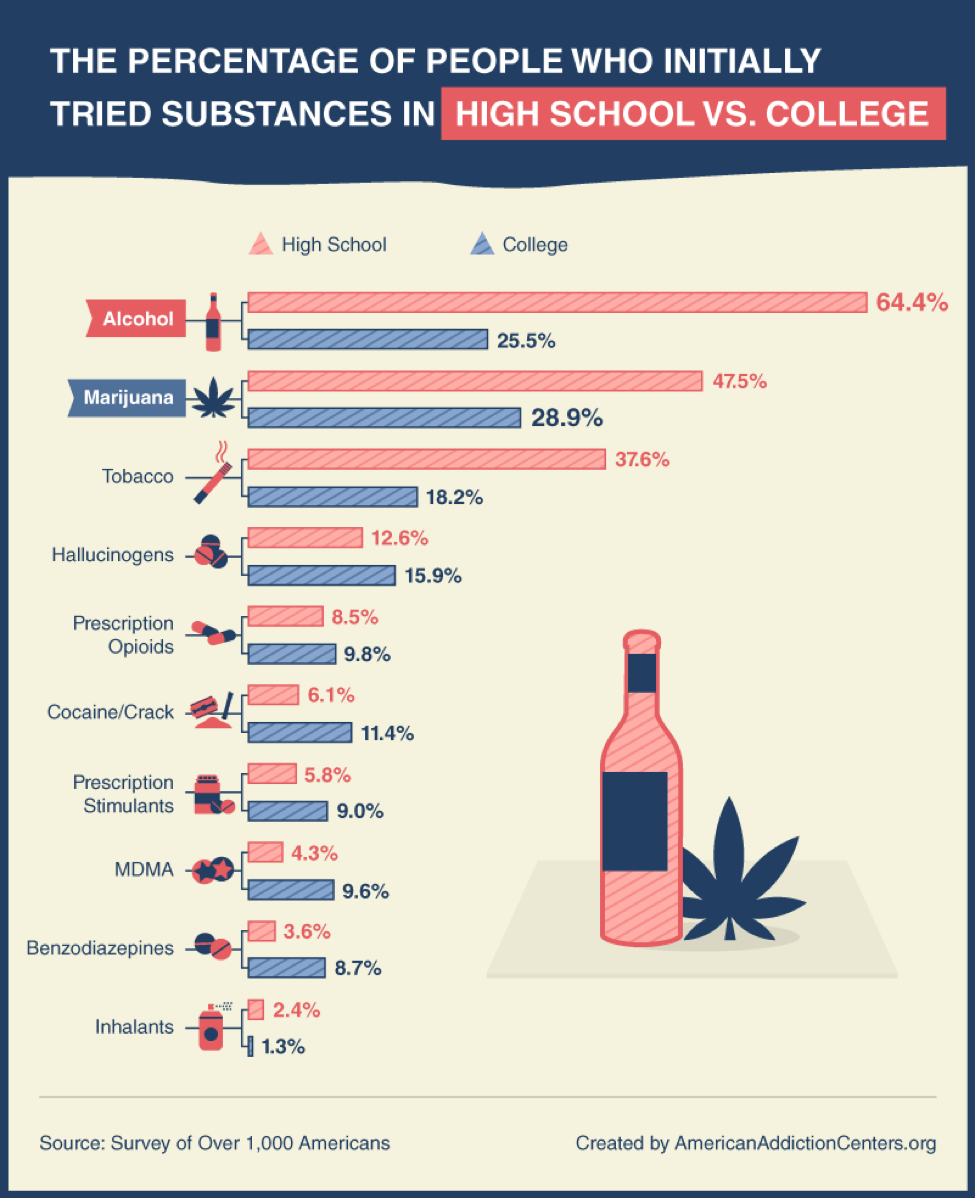Drug Use in High School and College
Drug use and experimentation tend to proliferate on college campuses. For those who can afford this experience, campuses are often a sanctuary for drug use. In high school, drinking alcohol was my only experience with substance use. Right before college, I was required to partake in an online program about alcohol – one that demonstrated how to minimize harms associated with drinking, such as not drinking if you are planning on driving, staying well hydrated, eating before you drink, knowing how many alcoholic beverages you’ve had, or spacing out the drinks you are already consuming. These strategies help to keep people safe and prevent deaths, and are referred to as harm reduction.
In my freshman year, I found myself in a position where drugs of all kinds were almost literally falling into my lap. How did this happen? I was encountering drugs I had never even heard of left and right, and with the emergence of online drug markets, it could be as easy as shopping on Amazon. I was not prepared to confront these situations. Though many can and do use drugs in a safe, moderate, and responsible way, education and harm reduction measures – not only for alcohol and binge-drinking, but also for other drugs – need to be improved.
In my experience, harm reduction resources focus around alcohol use; programs like AlcoholEdu provide online videos and questionnaires and orientation groups have discussions to minimize the risks associated with alcohol consumption and binge drinking. Even though most students are underage when entering college, schools provide information on how to more safely consume alcohol. Why not institute an online program and information about other drugs too? DPA’s Safer Partying campaign has some of this information for young people, as well as the organization DanceSafe. Moreover, Students for Sensible Drug Policies’ Just Say Know campaign is a student-led organization and puts pressure on educational institutions from within. But campus-based programs can ensure the best possible outcome for students that do choose to use drugs.
Informative programs should include other drugs that students may be using and could be an opportunity to address mental health resources, which are most often overlooked and underfunded. For example, psychedelic harm reduction focuses on de-escalation techniques – as laid out by Zendo (e.g. removing stimulation, talking through, not down, and sitting, not guiding), and could help students through difficult mental experiences without the introduction of medical assistance.
With the ongoing opioid overdose epidemic, specific harm reduction resources for opioids, such as information on potentially lethal interactions opioids have with alcohol are a great place to start. Adding naloxone trainings, where students could learn to use the life-saving overdose-reversal medication, should also be considered.
One of the biggest risks of illegal drug use is that people don’t really know what substances they are getting. In order to make sure students have a chance to be informed about what they ingest, drug checking kits should be easily available all year.
While the addition of these policies would help overall student health, schools and institutions must also think of ways to build trust with their students so that they feel safe to seek life-saving resources, predominantly ones unconnected to punitive measures and that focus on reparative and rehabilitative measures. Specifically, entities like emergency medical services (EMS) do keep students safe, but if they function in tandem with a college’s punitive student conduct enforcement, students will be distrustful and wary of using these resources.
Student communities also play a large role in creating a judgment-free, safe, and compassionate environment for all. On small campuses and other insular social groups, drug use can quickly become glorified or romanticized, especially through one’s social media presence. It is important to keep in mind how an increasingly prominent presence of drugs can affect those who struggle with addiction and with trauma. Educating students on how the images they produce affect those around them can also be a form of harm reduction.
In a time of learning, growing and experimentation, the reality is there always has been and always will be drug use on campus. We need to do everything we can to provide honest and accurate drug education with harm reduction strategies that keep our students as safe as possible.
All info from: http://www.drugpolicy.org/blog/drug-use-campus-how-can-we-keep-students-safe



Comments
Post a Comment